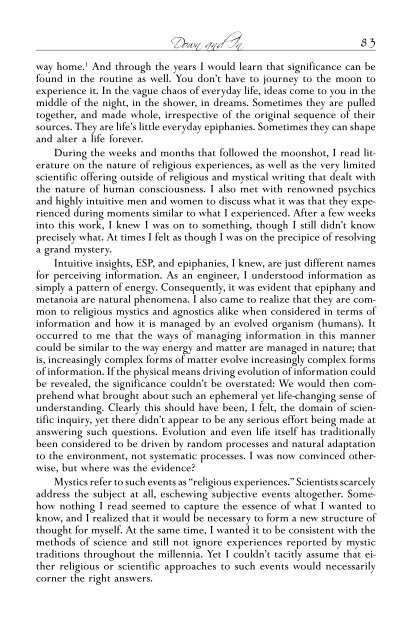edgar-mitchell
edgar-mitchell
edgar-mitchell
Create successful ePaper yourself
Turn your PDF publications into a flip-book with our unique Google optimized e-Paper software.
42<br />
The Way of the Explorer<br />
When our distant progeny look back and contemplate the history of<br />
all living matter, they will view our time, with respect to the Apollo missions<br />
in particular, as the third major transition in the evolution of living<br />
beings. The first transition could be defined as that moment when sea<br />
creatures finally left the primordial sea and moved about on dry land; the<br />
second, when creatures took to the Earth’s atmosphere; the third stage<br />
will likely be defined as that time during which we left the planet altogether<br />
in the latter half of the 20th century.<br />
From an anthropological point of view, space exploration must be<br />
undertaken not only out of simple human curiosity, but also to further<br />
ensure the survival of the species. The 20th century has seen the unprecedented<br />
development and proliferation of magnificent technologies—many<br />
of them, through design, ignorance, or misuse, are capable of destroying<br />
life as well as enhancing it. Space exploration alone holds the promise of<br />
eventual escape from a dying planet, provided we wisely manage our<br />
resources in the meantime, and actually survive that long.<br />
One of my first major decisions upon arriving in Houston was choosing<br />
to work on the lunar module itself as my technical assignment. Every<br />
week I would fly a T38 up to Bethpage, Long Island, to assist in the design,<br />
manufacture, and testing of the lunar module at Grumman Aircraft<br />
Corporation with Fred Haise. I recall the shock I felt the first time I saw a<br />
prototype of the machine that would one day land on and take off from<br />
the moon. I remember asking myself if we were really going to do it in that.<br />
It appeared so clumsy, top-heavy; so foreign to the act of flight. The insectlike<br />
posture seemed otherworldly. But in spite of its unconventional shape,<br />
it would prove to be an extraordinary flying machine. No one knew what<br />
a lunar module was supposed to look like, much less how it would respond<br />
to the pilot’s commands. But this was an attempt by some of the finest<br />
technical minds in aeronautics and astronautics to fill the bill. Being the<br />
first manned craft designed to fly only in orbit, it had no aerodynamic<br />
surfaces, and in fact would never return to the atmosphere of its home<br />
planet. After making its rendezvous with the command module and safely<br />
delivering its pilots, each lunar module was scheduled to be retargeted<br />
toward the moon, and to crash into the crater-riddled surface. Its impact<br />
would be measured by seismic equipment earlier set in place by astronauts<br />
during their brief stay there. Innovation was a part of the daily routine, as<br />
there was no tried-and-true blueprint for what we were doing.<br />
During the first Apollo missions I met the German successor to my old<br />
neighbor Robert Goddard, Wernher von Braun, in Huntsville, Alabama.<br />
This was the man whom I had heard so much about—much of it critical of<br />
his past. But the man I came to know was very different from the mythic


